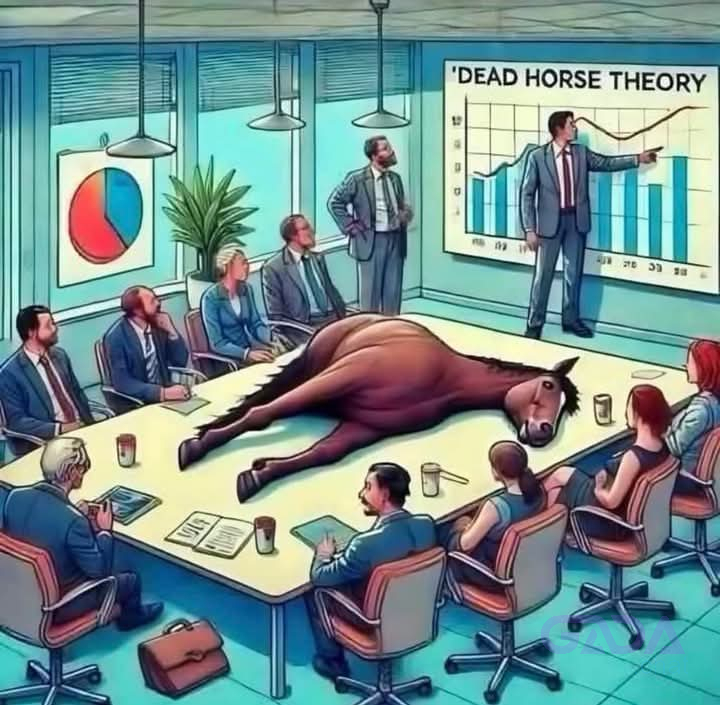The “Dead Horse Theory” is a satirical metaphor that illustrates how some individuals, institutions, or nations handle obvious, unsolvable problems. Instead of accepting reality, they cling to justifying their actions.
The core idea is simple: if you realize you’re riding a dead horse, the most sensible thing to do is dismount and move on.
However, in practice, the opposite often happens. Instead of abandoning the dead horse, people take actions such as:
• Buying a new saddle for the horse.
• Improving the horse’s diet, despite it being dead.
• Changing the rider instead of addressing the real problem.
• Firing the horse caretaker and hiring someone new, hoping for a different outcome.
• Holding meetings to discuss ways to increase the dead horse’s speed.
• Creating committees or task forces to analyze the dead horse problem from every angle. These groups work for months, compile reports, and ultimately conclude the obvious: the horse is dead.
• Justifying efforts by comparing the horse to other similarly dead horses, concluding that the issue was a lack of training.
• Proposing training programs for the horse, which means increasing the budget.
• Redefining the concept of “dead” to convince themselves the horse still has potential.
The Lesson:
This theory highlights how many people and organizations prefer to deny reality, wasting time, resources, and effort on ineffective solutions instead of acknowledging the problem from the start and making smarter, more effective decisions.
What are your thoughts about this theory?
The core idea is simple: if you realize you’re riding a dead horse, the most sensible thing to do is dismount and move on.
However, in practice, the opposite often happens. Instead of abandoning the dead horse, people take actions such as:
• Buying a new saddle for the horse.
• Improving the horse’s diet, despite it being dead.
• Changing the rider instead of addressing the real problem.
• Firing the horse caretaker and hiring someone new, hoping for a different outcome.
• Holding meetings to discuss ways to increase the dead horse’s speed.
• Creating committees or task forces to analyze the dead horse problem from every angle. These groups work for months, compile reports, and ultimately conclude the obvious: the horse is dead.
• Justifying efforts by comparing the horse to other similarly dead horses, concluding that the issue was a lack of training.
• Proposing training programs for the horse, which means increasing the budget.
• Redefining the concept of “dead” to convince themselves the horse still has potential.
The Lesson:
This theory highlights how many people and organizations prefer to deny reality, wasting time, resources, and effort on ineffective solutions instead of acknowledging the problem from the start and making smarter, more effective decisions.
What are your thoughts about this theory?
The “Dead Horse Theory” is a satirical metaphor that illustrates how some individuals, institutions, or nations handle obvious, unsolvable problems. Instead of accepting reality, they cling to justifying their actions.
The core idea is simple: if you realize you’re riding a dead horse, the most sensible thing to do is dismount and move on.
However, in practice, the opposite often happens. Instead of abandoning the dead horse, people take actions such as:
• Buying a new saddle for the horse.
• Improving the horse’s diet, despite it being dead.
• Changing the rider instead of addressing the real problem.
• Firing the horse caretaker and hiring someone new, hoping for a different outcome.
• Holding meetings to discuss ways to increase the dead horse’s speed.
• Creating committees or task forces to analyze the dead horse problem from every angle. These groups work for months, compile reports, and ultimately conclude the obvious: the horse is dead.
• Justifying efforts by comparing the horse to other similarly dead horses, concluding that the issue was a lack of training.
• Proposing training programs for the horse, which means increasing the budget.
• Redefining the concept of “dead” to convince themselves the horse still has potential.
The Lesson:
This theory highlights how many people and organizations prefer to deny reality, wasting time, resources, and effort on ineffective solutions instead of acknowledging the problem from the start and making smarter, more effective decisions.
What are your thoughts about this theory?





